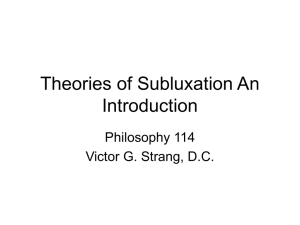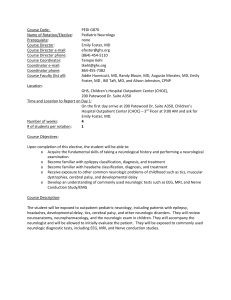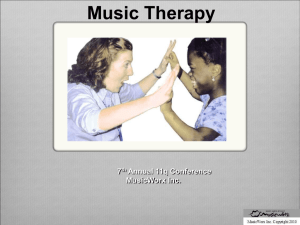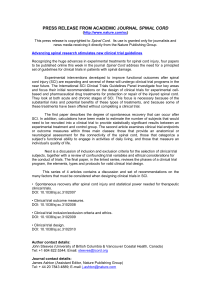General Medical Officer (GMO) Manual: Clinical Section
advertisement
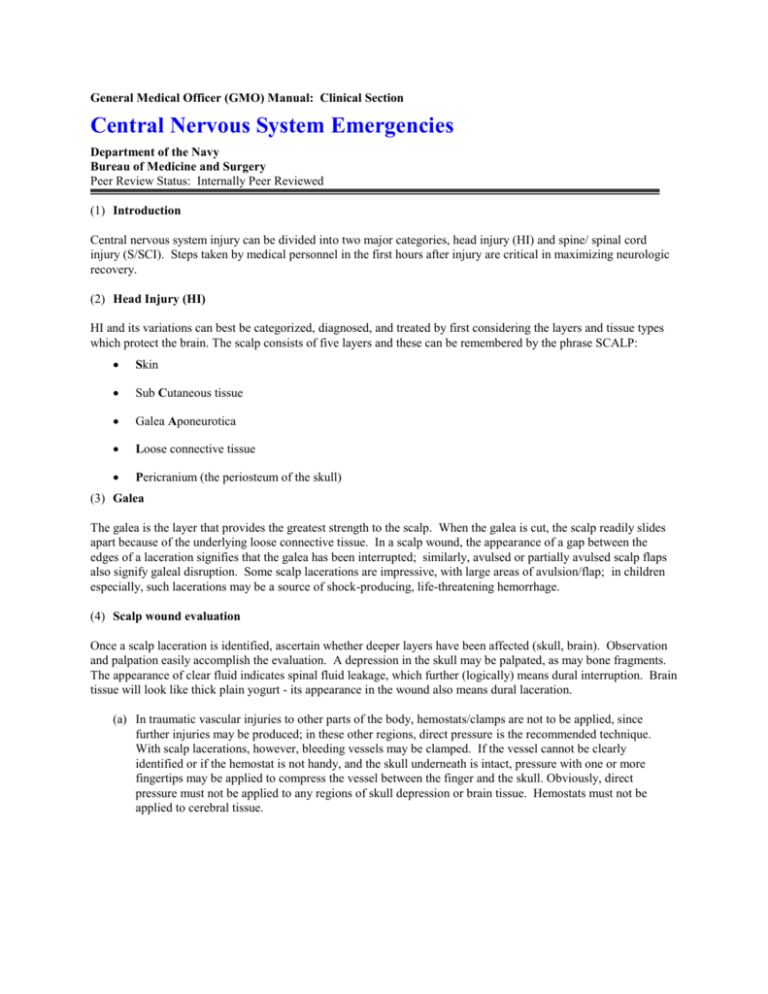
General Medical Officer (GMO) Manual: Clinical Section Central Nervous System Emergencies Department of the Navy Bureau of Medicine and Surgery Peer Review Status: Internally Peer Reviewed (1) Introduction Central nervous system injury can be divided into two major categories, head injury (HI) and spine/ spinal cord injury (S/SCI). Steps taken by medical personnel in the first hours after injury are critical in maximizing neurologic recovery. (2) Head Injury (HI) HI and its variations can best be categorized, diagnosed, and treated by first considering the layers and tissue types which protect the brain. The scalp consists of five layers and these can be remembered by the phrase SCALP: Skin Sub Cutaneous tissue Galea Aponeurotica Loose connective tissue Pericranium (the periosteum of the skull) (3) Galea The galea is the layer that provides the greatest strength to the scalp. When the galea is cut, the scalp readily slides apart because of the underlying loose connective tissue. In a scalp wound, the appearance of a gap between the edges of a laceration signifies that the galea has been interrupted; similarly, avulsed or partially avulsed scalp flaps also signify galeal disruption. Some scalp lacerations are impressive, with large areas of avulsion/flap; in children especially, such lacerations may be a source of shock-producing, life-threatening hemorrhage. (4) Scalp wound evaluation Once a scalp laceration is identified, ascertain whether deeper layers have been affected (skull, brain). Observation and palpation easily accomplish the evaluation. A depression in the skull may be palpated, as may bone fragments. The appearance of clear fluid indicates spinal fluid leakage, which further (logically) means dural interruption. Brain tissue will look like thick plain yogurt - its appearance in the wound also means dural laceration. (a) In traumatic vascular injuries to other parts of the body, hemostats/clamps are not to be applied, since further injuries may be produced; in these other regions, direct pressure is the recommended technique. With scalp lacerations, however, bleeding vessels may be clamped. If the vessel cannot be clearly identified or if the hemostat is not handy, and the skull underneath is intact, pressure with one or more fingertips may be applied to compress the vessel between the finger and the skull. Obviously, direct pressure must not be applied to any regions of skull depression or brain tissue. Hemostats must not be applied to cerebral tissue. (b) Scalp lacerations may be associated with severe underlying brain injuries. A patient with a severe injury or developing neurologic deficit must be rapidly evaluated for treatment and transfer. Except in unusual circumstances, burr holes (holes in the skull drilled to release blood clots) are not performed by GMOs, at least not without special training or concurrence in specified cases or situations. (5) Airway, breathing, and circulation (ABCs) Most GMOs have taken the Advanced Trauma Life Support (ATLS) course. While the amount of information presented in ATLS may appear overwhelming, the basic principle of first assessing the ABCs should be thoroughly understood and practiced by anyone dealing with a trauma patient. Do not give into the temptation of palpating a scalp wound or looking at the pupils until the patient has a secure airway, is breathing adequately, and has a stabilized circulatory status. Nothing is more important than the ABCs. After the ABCs, D (disability) and E (exposure) have been attended to, the secondary survey can be performed to include a more detailed examination of the patient's neurologic status. (6) The hallmark of brain injury: alteration of consciousness Evaluate what the patient responds to and what level of stimulation is necessary to produce a given response. The Glasgow Coma Scale (GCS) is used to grade the severity of injury. See the below table. The numbers are not as important as understanding the basic principles and being able to describe to someone what the patient can or cannot do at a given moment. Neurologic improvement or deterioration must be assessed early and frequently. Using the GCS, evaluate the patient according to the degree of stimulation required to produce a given response. Responses to stimuli allow the physician to determine the patient’s basic mental status. The initial exam will serve as a baseline with serial exams providing information that can indicate the stability of the clinical status and the effectiveness of treatments. Corpsmen, nurses, and doctors may have trouble remembering the GCS, but if you understand the idea behind it, you can still examine the patient and convey the information meaningfully. Glasgow Coma Scale Eye Opening E Best Verbal V Best Motor M spontaneous 4 oriented and converses 5 obeys commands 6 to voice command 3 confused 4 localizes to pain 5 to pain stimuli 2 inappropriate words 3 withdrawals from pain 4 no response 1 incomprehensible sounds 2 decorticate posturing 3 no sounds 1 decerebrate posturing 2 no response 1 E + V + M = 3 to 15 Recommended for age > 4 years The GCS is intended to assess level of consciousness, not follow focal neurologic deficits. (7) Major Areas to Focus on with Patients that Sustain a Head Injury: (a) ABCs (b) Disability (D). The goal of assessing disability is to determine neurologic injury. Key components of this evaluation are as follows: Mental status (GCS). Pupil exam. Motor/sensory exam of the extremities. (c) Decline in neurologic status. This will be noted by performing serial exams. It is fairly obvious that a patient who comes in talking and then stops talking and is decerebrate to painful stimulus has deteriorated. However, what are some earlier signs? Decrement in level of consciousness. A patient who was previously talking to you but now has to be shaken gently or have a painful stimulus applied before he or she talks to you, or other decline along the lines of the GCS. A pupil which becomes less responsive to light and larger than the opposite one. Pupils are best examined in a darkened room; otherwise the ambient light causes stimulation and rest/response sizes are misgauged. When neurologic decline occurs, additional treatment modalities need to be considered and transfer must be implemented. (8) Treatment Remember, the ABCs must be maintained. In addition, there are some specific therapeutic interventions that can be implemented by the GMO to improve the head injury patient's chances of recovery. These efforts are directed at lowering the intracranial pressure. (a) Elevate the head of the bed Blood pressure stability/lability and the presence of shock will determine the extent at which this maneuver is performed. Be careful if the patient is secured on a long spine board and if a potential spinal injury exists. (b) Hyperventilation Traditional belief has mandated hyperventilation as a standard treatment for elevated intracranial pressure management. Hyperventilation lowers the pC02, which, in turn, decreases cerebral blood flow (CBF) and some of the intracranial mass contributed by the blood in the cerebral vessels. Unfortunately, the baseline CBF following head injury can be as low as 50 percent of normal. Recent studies have demonstrated that hyperventilation in the face of decreased CBF states results in ischemic injury to the brain. Thus, the current recommendation is to avoid hyperventilation except in an acute herniation syndrome. The optimum pC02 is 31-35 mm; below this, there is too much of a decrease in cerebral blood flow, and brain metabolism is compromised. (c) Fluid Restriction Keeping in mind that the "C" of the ABCs must be supported. Patients with HI should receive fluids necessary to perfuse all organs, including the brain. Again, "C" is always supported without regard to head injury, since inadequate cerebral perfusion is bad for the patient with HI. Avoid the use of hypotonic fluids. Maintain serum osmolality between 285-300. (d) Osmotic Agents/Diuretics These agents (urea or mannitol/lasix) may be administered in the event of neurologic deterioration only on the advice of a neurosurgeon. If the patient has required volume loading to treat shock, these agents will most likely cause shock again, and would therefore not be advised. (e) Other Treatment Options Barbiturates are sometimes used for cerebral protection in severe head injury. However, their use requires careful monitoring of intracranial pressure since these medications can negate neurologic exam results. Remember that assessing for changes in the neurologic exam can provide the best way of determining if the patient needs to be treated and/or transferred. (9) Vital information for the neurosurgeon (a) Status of the ABCs. (b) The patient's level of consciousness (GCS or equivalent in plain language). (c) Has he or she changed under your care? (d) Scalp/head injuries that can be visualized. (e) Results of any x-rays/labs and other injuries. (f) Mechanism of injury, if known. (10) Spine/Spinal Cord Injury Early evaluation and treatment of the patient with spine/spinal cord injury (S/SCI) is not difficult, as long as some basic principles are remembered and followed. Always suspect the presence of these types of injuries. Patients with head injuries and/or unconsciousness, supraclavicular injuries, or those involved in high-speed vehicular accidents are all suspect, as is the patient in whom there is an obvious neurologic deficit which can be traced to the spinal cord. (11) The second principle is immobilization. All patients who are suspected of having S/SCI should be completely immobilized on a spine board with collar and sandbags. The ATLS course and skill stations provide a basis for the techniques and equipment used in immobilization; common sense, and ingenuity may be needed in situations where standard equipment is unavailable. (12) Patient stability Concurrent with the suspicion and immobilization phases is the assessment of the ABCs. The airway and breathing of the S/SCI patient may be compromised by: (a) Local neck trauma or (b) Impairment of diaphragmatic/accessory muscle function. These patients may appear to have satisfactory respiratory function upon initial evaluation, but they frequently tire; this is best prevented by early intubation with (attention to immobilization), rather than waiting until the patient gets into serious trouble during transfer. (13) Circulation The next factor to assess is "C." A spinal cord injury, especially one that achieves complete physiologic or physical transection of the spinal cord, causes a sympathectomy. This is manifested by hypotension and bradycardia. The concurrence of SCI with hypotension and bradycardia is known as neurogenic shock; it is crucial to the survival of the patient to diagnose and treat any concomitant hypovolemic shock, since the SCI patient is unable to mount the characteristic tachycardia of hypovolemic shock. The SCI patient's neurologic dysfunction interferes with evaluation of the abdomen, pelvis, and legs, all places where significant causes of hypovolemic shock may lurk. Since the sympathectomy effect has essentially increased the volume of the intravascular tank, volume expansion may not have much of an effect on the blood pressure (BP). A BP of 90 mmHg, however, is adequate for perfusion in the supine position (which this patient will be in since he or she is properly immobilized). A foley catheter should be inserted to prevent bladder distention and assess renal function as an indicator of perfusion. (14) Neurologic Assessment Neurologic assessment of the patient is necessary to determine his or her initial status and to document any improvement or decrement in function. While a formal neurologic exam is required, impressions of the patient's neurologic function can be gained from his or her conduct during the initial phases of evaluation and resuscitation; how does he or she respond to the painful stimuli of IVs and blood drawing? Does the patient’s arms and legs move in response to stimuli? Flaccidity of muscles and absence of reflexes are the rule in the early hours and days following spinal cord injury; this symptom complex is known as spinal shock, and it usually is replaced by the classic spasticity and hyperactive reflexes of upper motor neuron lesions in several days to weeks following the injury. A critical determination is the presence or absence of sacral sensation; its presence denotes an incomplete spinal cord injury (some messages are getting past the injury), and signals a much more hopeful prognosis for return of neurologic function than for the patient in whom it is absent. (15) Treatment The primary job of the persons caring for a patient with a (potential) S/SCI is to prevent worsening of the neurologic status. This includes proper immobilization and continuous re-evaluation of the neurologic status. Definitive treatment is performed at a center with neurosurgical or orthopedic spine expertise. Controlled studies have demonstrated improved neurologic outcome in patients with spinal cord injury who receive steroids early after the injury. Steroid administration is indicated for non-penetrating spinal cord injury, but it must be given within 8 hours of the injury. The dosing of methylprednisolone is 30 mg/kg IV bolus over 15 minutes. Forty-five minutes after bolus completion, start methylprednisolone infusion at 5.4 mg/kg/hr for 23 hours. (16) Transfer planning and recommendations Vital information for the accepting physician includes the patient's neurologic status and course while under observation, the status of the ABCs, and any associated injuries. Careful transfer of the patient must be carried out, and pretransfer thought given to any untoward events which might be anticipated by the patient's status. Pretransfer intubation may need to be considered, depending upon severity of injury, distance, mode of transfer, and sophistication of personnel accompanying the patient. (17) Prevention Prevention is the best treatment for spinal cord injuries. The GMO can help prevent spinal cord injuries by encouraging each patient to use seat belts, drive a car with an airbag, and avoid driving while intoxicated. Also encourage patients to avoid traveling as a passenger with an intoxicated driver. Diving represents another mechanism of injury, particularly in locations where depth/obstacles may be unknown. The neurosurgical community has encouraged the feet first, first time campaign to try to minimize the occurrence of diving-related SCI. Prevention works best. Reviewed and revised by CDR Robert Heim, MC, USN, Neurosurgery Specialty Leader and Staff Neurosurgeon, National Naval Medical Center, Bethesda, MD. (1999).

